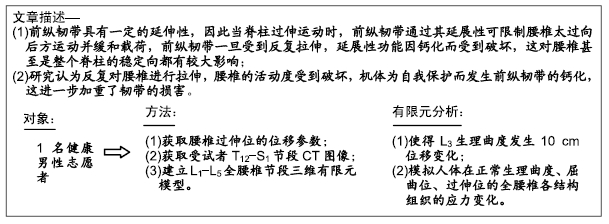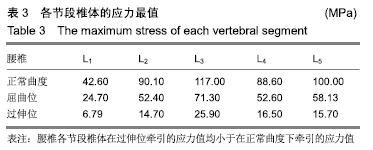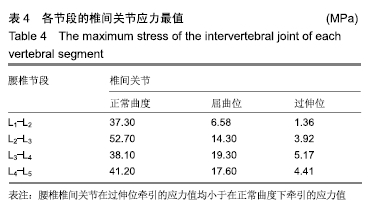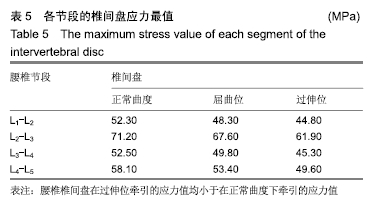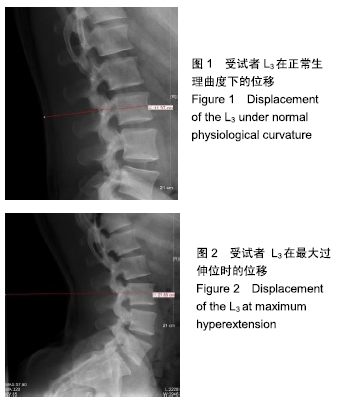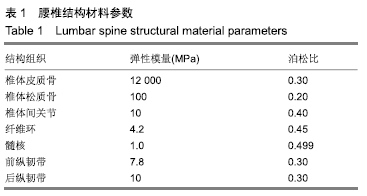[1] MAKHSOUS M, LIN F, BANKARD J, et al. Biomechanical effects of sitting with adjustable ischial and lumbar support on occupa tional low back pain: evaluation of sitting load and back muscle activity. BMC Musculoskelet Disord.2009;10:17.
[2] 王小明,刘兴炎,姚晓群,等.慢性腰痛与腰椎前凸的相关性调查[J].实用放射学杂志,2006,22(2): 223-225.
[3] LV QB, GAO X, PAN XX, et al.Biomechanical properties of novel transpedicular transdiscal screw fixation with interbody arthrodesis technique in lumbar spine: A finite element study.J Orthop Translat. 2018;15:50-58.
[4] ALVARENGA JC, BOYD SK, PEREIRA RMR.Pereira.The relationship between estimated bone strength by finite element analysis at the peripheral skeleton to areal BMD and trabecular bone score at lumbar spine.Bone. 2018;117:47-53.
[5] XU M, YANG J, LIEBERMAN I, et al.Stress distribution in vertebral bone and pedicle screw and screw–bone load transfers among various fixation methods for lumbar spine surgical alignment: A finite element study.Med Eng Phys. 2019;63:26-32.
[6] FORESTO T, SONG I, KIM BS, et al. Stabilization of the lumbar spine by spinal muscle forces producing compressive follower loads: 3-dimensional computational study.J Orthop Res. 2018; 36(11):3004-3012.
[7] DEHGHAN-HAMANI I, ARJMAND N, SHIRAZI-ADL A. Subject-specific loads on the lumbar spine in detailed finite element models scaled geometrically and kinematic‐driven by radiography images. Int J Numer Method Biomed Eng. 2019;35(4):e3182.
[8] FAN W, GUO LX.Biomechanical comparison of the effects of anterior, posterior and transforaminal lumbar interbody fusion on vibration characteristics of the human lumbar spine. Comput Methods Biomech Biomed Engin. 2019;22(5): 490-498.
[9] WANG MD K, JIANG PHD C, WANG PHD L, et al.The biomechanical influence of anterior vertebral body osteophytes on the lumbar spine: a finite element study.Spine J. 2018;18(12):2288-2296.
[10] YANG HS, YOO WG.The effects of stretching with lumbar traction on VAS and Oswestry Scales of patients with lumbar 4–5 herniated intervertebral disc.J Phys Ther Sci.2014;26 (7):1049-1050.
[11] CHANGQING L, YUE Z, HONGWEI W, et al.Treatment of Unstable Thoracolumbar Fractures through Short Segment Pedicle Screw Fixation Techniques Using Pedicle Fixation at the Level of the Fracture: A Finite Element Analysis.PLoS ONE.2014;9(6):1-9.
[12] XU G, FU X, DU C , et al. Biomechanical effects of vertebroplasty on thoracolumbar burst fracture with transpedicular fixation: A finite element model analysis.Orthop Traumatol Surg Res. 2014;100(4):379-383.
[13] 贺鑫,李民,陈立典,等. 一种脊柱牵伸床的研制[J].中国医疗设备, 2014,29(10):35-37.
[14] 陈立典.多层气柱式脊柱垫的脊柱牵伸气柱手法CN201410015409.0[P]. 2014-04-09. https://kns.cnki.net/kns/brief/result.aspx?dbprefix=SCOD
[15] 陈立典.多层气柱式脊柱垫的气柱控制结构CN201410015433.4[P]. 2014-04-09. https://kns.cnki.net/kns/brief/result.aspx?dbprefix=SCOD
[16] 陈立典.多层气柱式脊柱垫及其应用方法CN201410015518.2[P]. 2014-04-02. https://kns.cnki.net/kns/brief/result.aspx?dbprefix=SCOD
[17] 陈立典,李民.一种可个性化调节曲度的分段式脊柱牵伸床:中国, CN201610948100.6[P]. 2017-03-22. https://kns.cnki.net/kns/brief/result.aspx?dbprefix=SCOD
[18] 陈立典,贾小飞,李民.分段式脊柱牵伸床用可个性化调节曲度的三维气垫结构:中国, CN201610956475.7[P].2017-01-25. https://kns.cnki.net/kns/brief/result.aspx?dbprefix=SCOD
[19] 陈立典,李民.可个性化调节曲度分段式脊柱牵伸床的三维动作控制装置:中国, CN201610956498.8[P].2017-02-22. https://kns.cnki.net/kns/brief/result.aspx?dbprefix=SCOD
[20] 王和鸣,王诗忠.南少林理筋整脊手法图谱[M].北京:中国中医药出版社.2015.
[21] YAMAMOTO I, PANJABI M, CRISCO T, et al. Three-dimensional movements of the whole lumbar spine. Spine.1989, 22(10):1103-1103.
[22] XIAO Z, WANG L, GONG H, et al. Biomechannical evaluation of three surgical scanarious of posterior lumbar interbody fusion by finite analysis.Biomed Eng Online.2012;11:31.
[23] ROBERTSON D, CALDWELL G, HAMILL J, et al.Research Methods in Biomechanics.2nd ed.USA.Human Kinetics. 2013:69.
[24] 徐海涛. 腰椎手法推拿力的量化研究和有限元分析[D].广州:南方医科大学, 2008:31.
[25] TADANO S, TANABE H, ARAI S, et al. Lumbar mechanical traction: a biomechanical assessment of change at the lumbar spine.BMC Musculoskelet Disord. 2019;20(1):155.
[26] ADAMS MA,MCNALLY DS, WAGSTAFF J, et al. Abnormal stress concentrations in lumbar intervertebral discs following damage to the vertebral bodies: a cause of disc failure. Eur Spine J.1993;1(4): 214-221.
[27] 戴力扬,屠开元,徐印坎,等.腰椎椎体应力分布的三维有限元分析[J].中国临床解剖学杂志,1991,9(1):46-48.
[28] POLLINTINE P, DOLAN P, TOBIAS JH, et al.Intervertebral Disc Degeneration Can Lead to “ Stress-Shielding ”of the Anterior Vertebral Body.Spine.2004;29(7): 774-782.
[29] KERIN AJ, WISNOM MR, ADAMS MA. The compressive strength of articular cartilage. Proceedings of the Institution of Mechanical Engineers -- Part H.1998;212(4):273-280.
[30] HORTIN M, GRAHAM S, BOATWRIGHT K, et al.Transversely isotropic material characterization of the human anterior longitudinal ligament.J Mech Behav Biomed Mater. 2015; 45:75-82.
[31] 石国生,周彦萍,李华,等.脊柱牵引的生物力学问题[J].中国临床康复,2003,7(2):265-266.
|
